
Latest updates are always at the bottom of the page.
I've been after one of these for YEARS after seeing a pic of one in the 1985 Microcomputer Buyer's Guide. This pic, in fact.
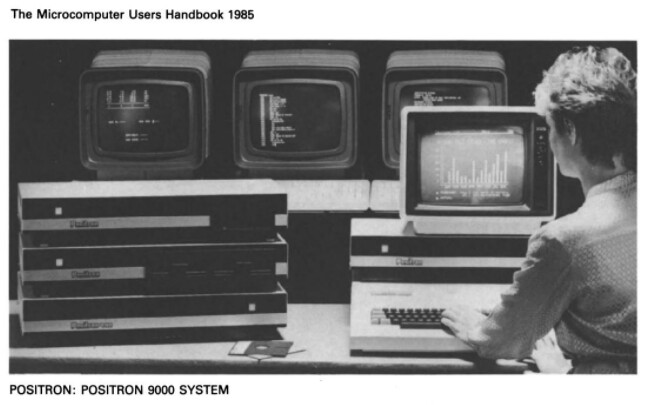
I thought this was one machine, but it turns out it's actually two. The left hand machine is the
Positron 900 with a dual floppy unit and Winchester hard drive. The terminals at the back will be attached to this machine.
The machine on the right is a Positron 9000 standalone workstation and is driving a colour TV.
My machine was found in a shed clearance by a chap called Steve who I bought it from. Unfortunately he
didn't know any history of this machine itself, and despite there being a GPIB cable with it there was no disk unit. I'm guessing
that because the machine itself is huge with brightly coloured keys it stood out, whereas the 9153 floppy drive box is plain so
might have been chucked if it was present at all. It's quite rusty so the shed obviously wasn't waterproof, fortunately the rust
is on the case and a small part of the board at the back.
I've contacted Peter Plinston on Linkedin, wrote to his accountants in Bath and even sent a Real Letter to his last known postal address, but no
response as yet, so if you know anything at all about these machines please let me know!
Pictures
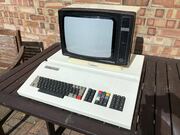 | 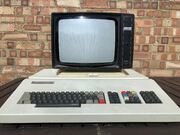 | 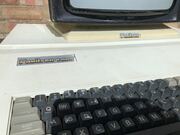 | 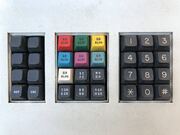 |
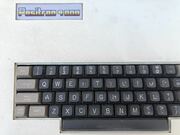 | 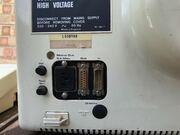 | 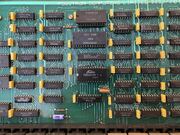 | 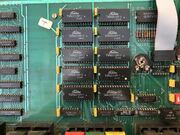 |
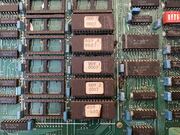 | 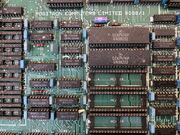 | 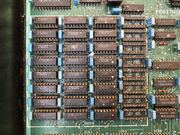 | 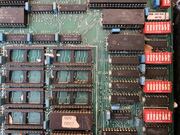 |
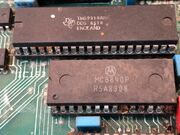 | 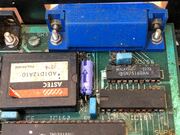 | 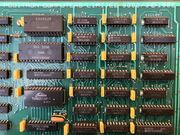 | 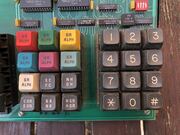 |
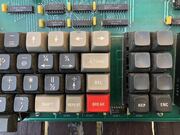 | 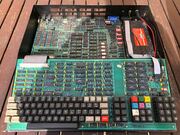 | 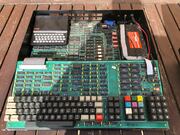 | 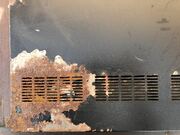 |
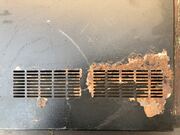 | 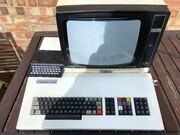 | 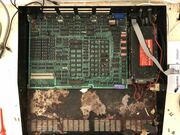 | 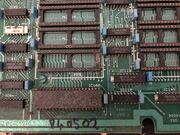 |
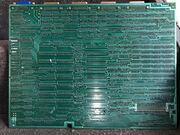 | 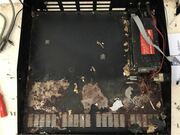 | 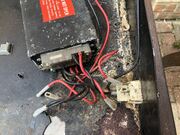 | 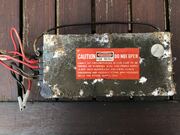 |
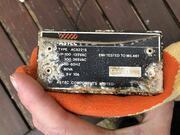 | 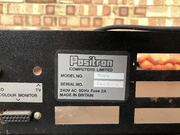 | 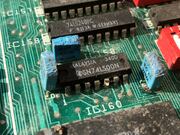 | 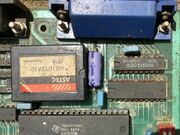 |
Update Feb 2022
On initial inspection, the 9000 had had a rough couple of decades in storage. Clearly damp, the board was also covered with
the evidence of rodent infestation, right down to the smell and the tops being removed from the nice blue decoupling capacitors, by sharp
teeth. Thankfully, this activity was confined to the right hand side of the board. The PSU looked like a biohazard, and once removed revealed a little
sticker saying 'Faulty' so we can surmise what happened to this board given that there's no further regulation!
After lots of photos and a trip through the dishwasher things looked and smelled a little better; it was obvious that a lot of
the chips on the right had rotted thanks to the constant flow of rodent pee and rain, but fortunately these chips appear to be solely IEEE488 based for the
external cabinets. None of them were unobtanium so I set about replacing the obviously dead/rotted chips.
Of course, nobody had any idea as to how this machine worked, but thanks to the ROMs being complete and readable I discovered
all of OS/9 Level 2 was present, meaning the machine COULD in theory boot on its own. Trouble is, testing showed that quite a lot of the chips were
completely dead so I began to wonder if the PSU had spiked the whole board when it went 'faulty'. Three quarters of the RAM chips were dead as were quite a
lot of the LS244/245 drivers so I replaced all of them.
While all this testing was going on, Nigel Barnes and Mike Miller were working on a MAME port based off the ROM images. My biggest
challenge initially was finding a clock for them because there were no obvious crystals on the board. I eventually tracked down the crystal hiding in a plastic
package with an 8 pin socket. Testing for clock signals found one but it wasn't getting to the CPU. I traced that to a dead 74LS379 and suddenly: CPU
activity!
Still no signs of life though. The CPU got really hot so I replaced that too, and suddenly oscilloscope traces improved. As I was
doing this I was drawing out a schematic in KiCAD since nothing exists online for this machine. At all. I quickly discovered data to/from the CPU/ROM/MMUs
was controlled by a signal called DIR, coupled with chip enable. The next few months can be compressed into further schematic drawings, chip replacement,
circuit tracing and general puzzlement. At present we know the DIR pins are correct but ENABLE isn't so well. There's a LOT of decision making glue to
trace and check there.
Before the first and last retro event of 2021 at the Centre For Computing History in Cambridge Nigel and Mike succeeded in
getting the MAME emulation to run, after a fashion. At least we got to see what a boot screen looked like!
As of February 2022 the machine is still dead and I'm researching a better circuit tracing tool than my trusty Magic Sponge(tm)
which so far has done sterling work but I need something more precise for this beast of a board.
Update 1, Oct 2023
A message from Mort Smith, who ran a company called Intelfax that provided Viewdata services to
Channel 4 for their 4-Tel offering (Mort means MB when he talks about disk sizes, the first Positron Winchester was indeed 5MB):
"You're absolutely correct - when 4-Tel first started, we used Positron 9000 terminals to create the teletext pages. Software was written by our then technical director Andrew Wallis. I remember that we stored all our pages on a 5K winchester disk. Yes, I did mean 5K. Graduated to a 20K disk before we eventually switched all our production and transmission systems onto ATOM and RITE Editor machines which were designed and built buy our sister company Intelfax Developments Ltd. Software was designed by Ray Goff (who started off working for Logica and was largely responsible for creating the Context system used by the BBC to run CEEFAX.)"
"You're absolutely correct - when 4-Tel first started, we used Positron 9000 terminals to create the teletext pages. Software was written by our then technical director Andrew Wallis. I remember that we stored all our pages on a 5K winchester disk. Yes, I did mean 5K. Graduated to a 20K disk before we eventually switched all our production and transmission systems onto ATOM and RITE Editor machines which were designed and built buy our sister company Intelfax Developments Ltd. Software was designed by Ray Goff (who started off working for Logica and was largely responsible for creating the Context system used by the BBC to run CEEFAX.)"
Update 2, Oct 2023
Excitement in BinarySaurs towers as Positron hardware engineer Ron Murphy has sent me the
schematics for my 9000/1 and I'm delighted to see that my own hand drawn version is 99% correct - the principle mistakes I've found have been OR gates flipped
in my version so the pin numbering is upside down. In the real version the 74LS30 8-to-1 NAND gates are drawn aligned with their purpose which makes things a
LOT easier to understand. I should've thought of that! Many thanks, Ron. See the Links section below.
Rebuild Pictures
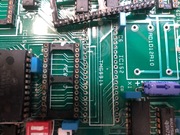 | 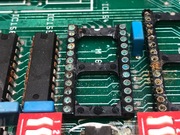 | 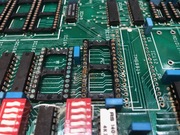 | 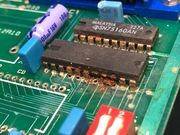 |
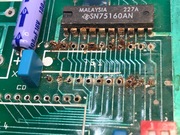 | 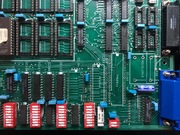 | 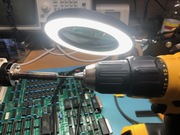 | 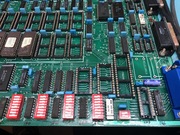 |
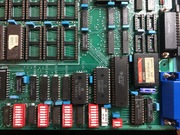 |  | 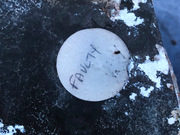 | 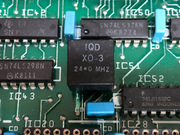 |
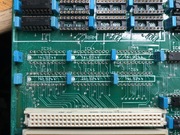 | 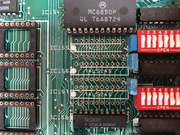 | 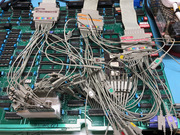 | 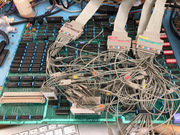 |
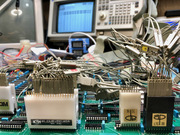 | 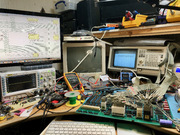 | 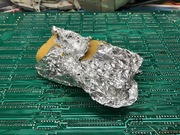 |  |
Links
Full version of the 9000/1 drawings, stitched together by me. 28MB in size.